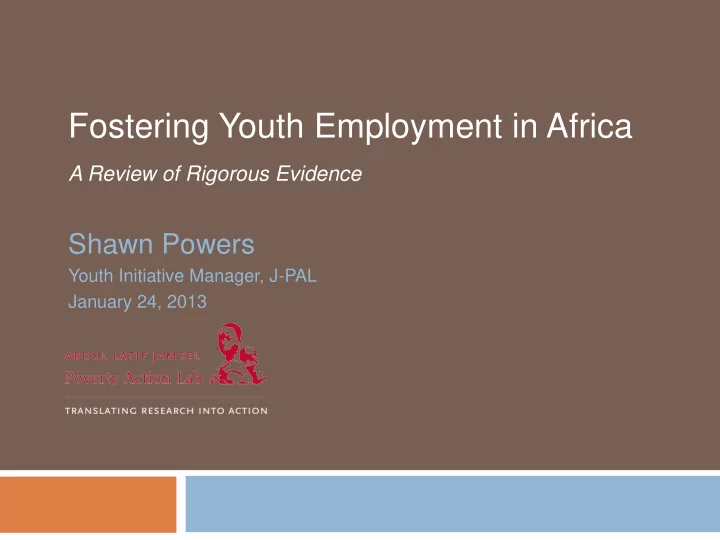

Fostering Youth Employment in Africa A Review of Rigorous Evidence Shawn Powers Youth Initiative Manager, J-PAL January 24, 2013
Outline About J-PAL J-PAL’s Youth Initiative Findings from the literature review Employability Active Labor Market Policies Discussion
J-PAL has a Network of 72 Affiliated Professors
5 Regional Offices, 350+ Completed and Ongoing Evaluations in 7 Thematic Areas
J-PAL’s Youth Initiative Initiative Concept: fund that supports coordinated research agenda on a topic where policy-relevant evidence is needed Begins with review paper to identify state of knowledge Focused on micro-level interventions Updated version coming soon on J-PAL website Researchers compete for funding through several rounds of request for proposal (RFP) One round of RFP complete—more on this later 5
What do We Mean by Rigorous Evidence? Impact of programs is hard to assess because of selection bias —those in the program differ systematically from those outside it More motivated people go to training → impact of training may be overestimated People with worse job prospects go to training → impact may be underestimated
What do We Mean by Rigorous Evidence? J-PAL affiliates conduct Randomized Evaluations If implemented correctly, simple way to solve the selection problem Ensures that only systematic difference between groups is random assignment to the program Review also includes other research that is careful about cause and effect Descriptive work helps define problem, suggest solutions, interpret results
Outline About J-PAL J-PAL’s Youth Initiative Findings from the literature review Employability Active Labor Market Policies Discussion
Employability: Motivation Family environment, household resources play powerful roles in skill formation Both cognitive and non-cognitive skills are significant inputs into: educational outcomes wages labor force attachment propensity to engage in risky behavior Substantial gaps in children from different socioeconomic backgrounds on cognitive and non-cognitive skills
Importance of Early Investments Health Mass deworming in Kenya improved adult labor market outcomes (Baird et al. 2011) Iodine supplementation in utero increased schooling in Tanzania (Field, Robles, and Torero 2009) Large body of research on critical or sensitive periods Mostly from outside Africa (e.g. US preschool literature) But likely generalizable
Education Access/Attendance Providing information on economic benefits of schooling highly cost-effective in Madagascar (Trang 2008) Conditional cash transfers (CCTs) shown effective in Malawi even with small transfers (Baird, MacIntosh, and Ozler 2011) Quality Many successful primary-level interventions cluster around theme of “teaching at the right level” Tracking in Kenya (Duflo, Dupas, and Kremer 2011) Community teacher assistants in Ghana (A. Duflo, forthcoming)
Education: Post-Primary Much less known at this level Emerging challenge with swelling ranks of primary- educated students, shortage of qualified teachers Ongoing work on vocational education (Hicks et al.) Out-of-school Kenyan youths randomly selected to receive voucher (US $325) for vocational training Half of vouchers restricted to public training institutes, half unrestricted Measuring returns to public and private training
Employability: Some Key Open Questions How late is too late? Are there effective interventions to develop non-cognitive skills for adolescents? Many questions around how to deliver quality, relevant post-primary education J-PAL also starting a Post- Primary Education Initiative to address these topics
Outline About J-PAL J-PAL’s Youth Initiative Findings from the literature review Employability Active Labor Market Policies Discussion
ALMPs: Motivation Many governments and other institutions implementing training, job search assistance, job creation programs Generally discouraging picture in literature Often short-term benefits dissipate over time But implementation often precludes precise estimation of impact Severe selection problem Large administrative datasets – often poor quality
Job Training Programs Apprenticeships are primary model in Africa Descriptive work (Haan and Serriere 2002) suggests some challenges Incentivizing the trainers: may not want competition Barriers to access for females Costs often prohibitive: fees, transportation, and (often most importantly) opportunity cost of time
Job Training Programs Evidence from Latin America Modest effect on earnings in Dominican Republic (Card et al. 2011) Mix of in-class and on-the-job training in Colombia increased employment, earnings for women (Attanasio, Kugler, and Meghir 2009)
Public Works Evidence from Europe (Kluve 2010) and developing countries (Betcherman, Olivas, and Dar 2004) countries suggests these programs are rarely effective beyond length of employment Often fail to target poorest South Africa (Adato and Haddad 2002), Kenya and Botswana (Teklu and Asefa), Liberia (Andrews et al. 2011) Pre-post analysis in Liberia suggests program reduced depth of poverty (Andrews et al. 2011)
Informational Interventions Paradox of unemployment and vacancies In Egypt, 1.5m unemployed youth and 600,000 vacancies in formal sector firms Evidence from several African countries that youth have unrealistic expectations about job market and wages South Africa (Levinsohn and Pugatch 2009), Tunisia (Stampini and Verdier-Chouchane 2011), Morocco (Boudarbat 2005) Little research on job search assistance Evidence from France that displacement can be a problem (Crepon et al., forthcoming)
Employment in Conflict Areas Reintegration of ex-combatants a major challenge Promising results for agricultural training in Liberia (Annan and Blattman 2011) After 18 months, participants 37 percent more likely to have sold crops, spent fewer hours on illegal activites Ongoing work Cognitive-behavioral therapy, life skills training, and grants for Liberian street youth (Blattman, Jamison, Sheridan) Training in business skills and group dynamics for women in Uganda (Annan et al)
ALMPs: Some Key Open Questions In general, we need more rigorous evidence on ALMPs, and more evidence from Africa Can different interventions be usefully combined, e.g. training and job search assistance? Could information campaigns or counseling help reset unrealistic expectations? Optimal design of job training programs, such as apprenticeships
Youth Initiative Next Steps Projects funded in first RFP with support from Nike Foundation Negotiation skills for adolescent girls in Zambia National Apprenticeship Program, Ghana Information and postsecondary education decisions, Peru Actively seeking partners for funding, research, dissemination
Thank You! smpowers@mit.edu
Recommend
More recommend